Gauge & Scale
Introducing Dual Gauge in G
Feb 25, 2009


By Rick Henderson
LSOL.com Associate Editor |
Author
Bio
Where short-line narrow gauge railroads met mainline standard gauge railroads, there were often merging tracks in two gauges. Instead of having two separate yards for each gauge, railroads merged the gauges together so both gauges could operate on the same track.
|
Where short-line narrow gauge railroads met mainline standard gauge railroads, there were often merging tracks in two gauges. Instead of having two separate yards for each gauge, railroads merged the gauges together so both gauges could operate on the same track. This saved space and money. This practice is known as dual gauge track and typically one rail size is common to both gauge widths. 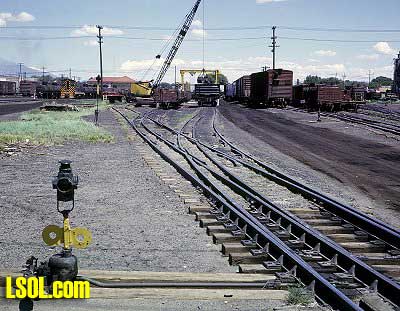
Click for Larger Image
A working dual gauge yard.
I have not seen any wide spread attempt to do dual gauge modeling in G outside of 1:20.3 scale. Since 45mm track in 1:20 scale is for modeling 3' narrow gauge railroads, to also model standard gauge 4'-8 1/2" track and trains, both track and rolling stock need to be larger. The gauge for 1:20.3 scale standard gauge track is 70.64mm or 2.78", which is basically 2 3/4". For those that think G-gauge trains are almost too large, you would be overwhelmed by the size of a 1:20.3 standard gauge car next to a 1:20.3 narrow gauge car. 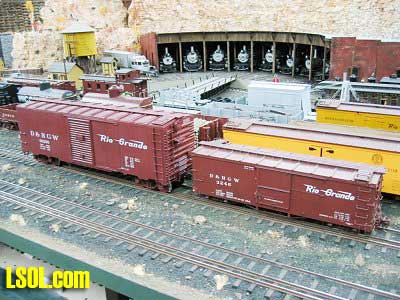
Berry Boggs dual gauge yard with standard gauge and narrow gauge, 1:22.5 scale cars on the same dual gauge track.
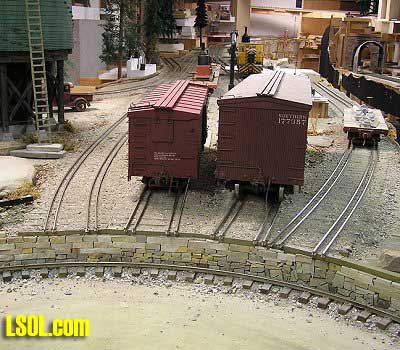
Click for Larger Image
Don Niday's dual gauge cars on turntable lead tracks.
Obviously having dual gauge trackage presents a new set of issues to consider. When laying out the narrow gauge track between the standard gauge track, should the narrow gauge work off the left rail or the right rail. The answer is either one and you can even have the narrow gauge on two separate rails set between the standard gauge rails, though this is not the most common approach. Another issue is use the same size of rail on dual gauge. If you used code 332 rail for the standard gauge and add a code 250 rail for the narrow gauge line, the narrow gauge trains would be tilting towards the lower rail plus the smaller rail could not cross the larger rail at a frog.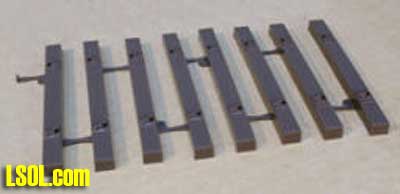
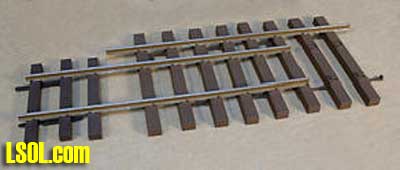
Dual gauge track tie strips are actually available for code 215 and 250 rail. They are 7 1/2" long and eight make up 5' of track. If you are going to the trouble of modeling in 1:20.3 dual gauge, then it is obvious you would be doing it with a closer to scale rail size than 332. Code 215 rail would equal about 65 lbs rail while code 250 rail is equivalent to 80 lbs prototypical rail. Either is appropriate although the smaller size may be more suited for an earlier time period setting.
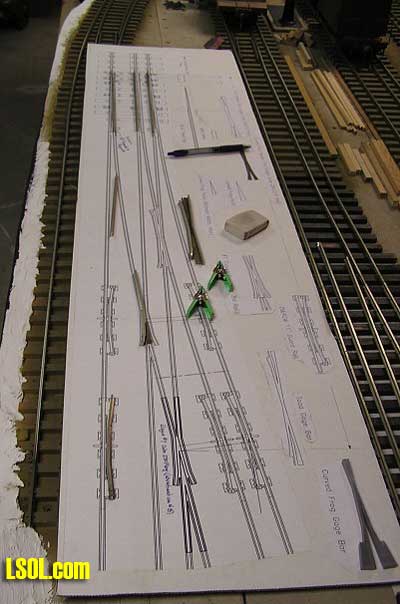 Dual gauge turnouts required three frogs to switch both gauges instead of one. Dual gauge turnouts are typically scratch built and are often custom built to fit the situation. When you plan out your yard area, you have to consider which side the narrow gauge will run common to and make the turnouts accordingly. Beyond considering left or right hand and frog number, you need to consider if the narrow gauge is on the left or right side and build accordingly. Then there is the option that only one gauge is diverging so that is a different custom turnout. Where a standard turnout has two choices for each frog #, left or right, dual gauge turnouts have 14 different layout patterns for each frog number. As I mentioned, the narrow gauge track could be common to the left rail or right rail and there may be times when you need to change which rail is the common. To achieve this, there must be a transition section that crosses over the narrow gauge track from one side to the other. There are even time when you transition to the center such as for a turntable. 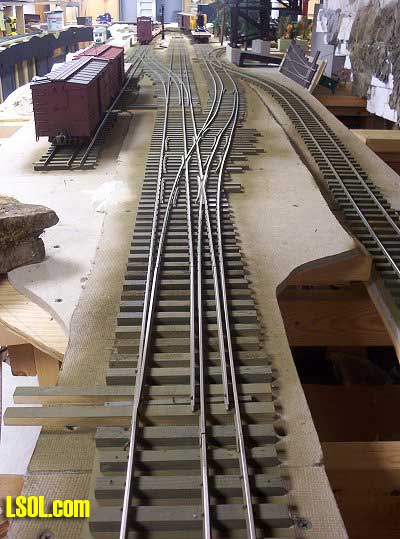
Click for Larger Image
Looking into a 1:20.3 dual gauge yard.
Looking close at the above photo you can pick out several of the variations in dual gauge trackage. Dual gauge turnouts with left and right side narrow gauge track, along with left and right diverging routes. On the right side you see the narrow gauge line switch into and then out of the dual gauge track through track. Since the narrow gauge on the dual gauge track was on the right side, those turnouts only required one frog each. To get from left side running up the center track, to right side running on the right track, notice the transition, just past the dual gauge turnout, moves the narrow gauge from left to right. This saved installing four extra frogs and at the next pair of turnouts.
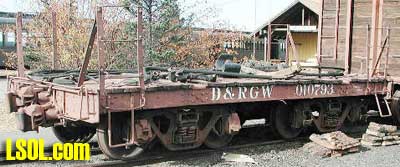
The dual gauge Idler CarWhen it comes to shuffling around cars in a dual gauge yard, there was often only one gauge of motive power to make the moves. An Idler flat was used that was just a short standard gauge flat with both standard gauge and narrow gauge couples on both ends. This allowed locomotives to move freight cars of other gauges anywhere there was dual gauge track. Modeling Dual Gauge in 1:20.3 Scale There are a limited number of items available in 1:20 Standard Gauge, the most important likely being the trucks. 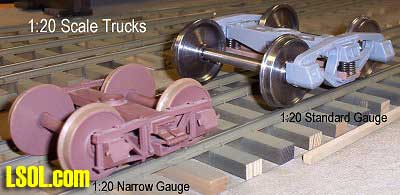
Click for Larger Image
There are two parts suppliers working in 1:20.3 Standard gauge to supply some parts for scratch builders. One is Cumberland Model Engineering Products and the other is Iron Creek Products owned by LSOL member Don Niday.
| Two For The Price Of One |
| Rick, This is a great companion piece to your Scale and Gauge article. Or is that Gauge and Scale? No matter! Thanks for taking the time to put this all together. Well done. |
| JD Miller - 02/25/2009 - 05:44 |
| Foggy head cleared up |
| Great article, Rick. I have a better appreciation of narrow vs standard now. Still baffled why smaller is bigger. |
| Mark Douglas - 02/25/2009 - 06:21 |
| dual guage tie strip |
| Who makes the dual gauge tie strip? Does it work for 332 or just 215 and 250? |
| Mike Evans - 02/25/2009 - 07:32 |
| Dual Gauge Tie Strips |
| The tie strips are only foe code 215 & 250 from http://www.cumberlandmodelengineering.com/IronCreekProducts.html |
| Rick Henderson - 02/25/2009 - 07:52 |
| dual gage |
| If you use 45 mm track for 1:32 scale, then three foot narrow gage is about 32 mm, or O-gage track. I've built a box car in 3' NG using O trucks, and it looks good, plus it's actually SMALLER than the standard gage equipment. Don't know if I've got a picture anywhere, but I'll look. |
| Dick Friedman - 02/25/2009 - 10:00 |
| dual gauge couplers |
| Just as an aside, sometimes the locomotives would have 2 different couplers on them to switch either gauge of cars. The narrow gauge coupler was offset on a standard gauge locomotive and the locomotive would actually have 2 pockets for the narrow gauge coupler, one offset to the left for left common rail, and one offset to the right for right common rail. |
| David A. Maynard - 02/25/2009 - 14:03 |
| Dual gauge tie strip |
| Sunset Valley Railroad sells dual gauge tie strips for their 250 rail. They also manufacture dual gauge turnouts. www.svrronline.com |
| Steven Fisher - 02/25/2009 - 14:48 |
Top of Page
|



